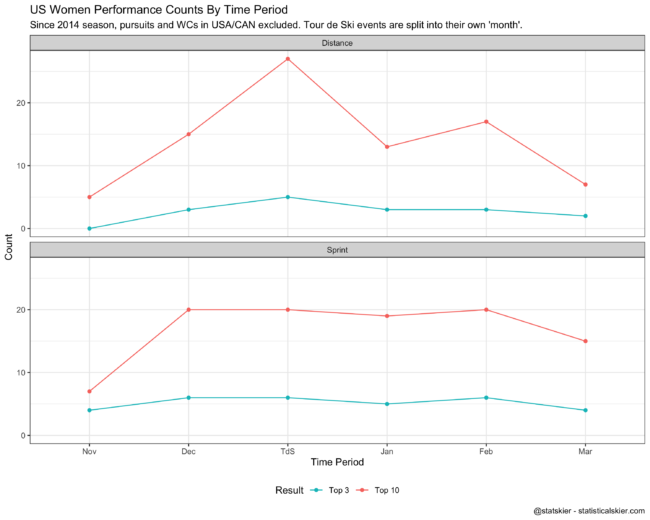I received an email recently asking the above question, and since responding to these sorts of things is often kind of challenging in an email I figured I’d just write it up here. I’m sure I’ve written about this sort of thing before, but it was probably a long time ago. Regardless, I’ve been looking at skiing results data for long enough now that I’ll admit to having some pretty strong priors when people ask me questions like this. Specifically, my gut reaction is to respond that whatever pattern you’re responding to is probably not going to be particularly evident if we start looking at it systematically. Then again, I’m sort of a statistical Debbie Downer so take that with a grain of salt.
Setting my depressing priors aside, let’s see what we see. So let’s start by taking all US women’s major international results over a sizable chunk of recent history, say since the 2013-2014 season. We’ll exclude pursuit starts, since they rather famously don’t compare well with anything else, and let’s also exclude events in USA/CAN to avoid having to worry too much about events with enormously expanded American starters. (This last one isn’t a huge number anyway.)
The FIS race calendar is mostly pretty predictable, but it does shift around from year to year. But let’s be simple about this and divide the races up by month. However, I’m going make a special allowance for the Tour de Ski and basically consider it a “month” by itself. Probably I’d guess that people who’ve done it might be ok with labelling it as a month’s worth of racing, anyway. So our “months” are Nov, Dec, TdS, Jan, Feb and Mar. That’s a little weird, but hopefully it makes sense.
Again, simple is the best place to start, so let’s just count up American women top 3 and top 10 results in those time periods since 2014:

Three things immediately jump out: a noticeable lack of top results in November (i.e. Ruka), an apparent spike in good distance results during the Tour de Ski and a very consistent rate of top results in sprinting after November.
Yes, yes, I hear you all shouting at me through the internet about needing to look at rates not counts, so let’s divide all these by the total number of results (i.e. how many US women finished a race in that time period):

See, now that’s kind of interesting! It’s almost like things completely reversed between the distance and sprint results. We still see pretty low rates of top results in November, but now the rate of top distance results is the more stable of the two and the rate of top sprint results has an obvious peak during the Tour de Ski.
Circling back to the original question, my Debbie Downer-ism was mostly correct in that there isn’t some very obvious peak in Nov/Dec that steadily declines throughout the season. But that doesn’t mean this was all a waste, of course.
What’s going on here, I think, is two things: I suspect the US may have made the Tour de Ski a focus for their season in ways that perhaps other nations have not, and if you do focus on the Tour and finish it you’re likely to be rewarded with some significantly reduced field strengths and sizes in the later stages.
Frankly, what’s most interesting to me about all this is the relative lack of success at the Ruka races in November. I don’t know if that’s the result of intentional strategic choices or if perhaps the races and formats haven’t really suited as many of the US women as other events have. Perhaps I’ll have to write a follow up that digs into that a little further.